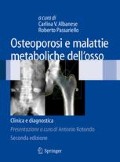Riassunto
Il fosforo è un componente essenziale delle cellule dell’organismo; i fosfolipidi, le fosfoproteine, gli acidi nucleici e tutti i composti intracellulari contenenti fosforo, come l’adenosina trifosfato (ATP), la guanosina trifosfato (GPT), il guanin monofosfato ciclico (cGMP), la nicotinamide-adenin-dinucleotide (NAD) e il 2,3 difosfoglicerolo (2,3-DPG) sono responsabili del mantenimento di molte funzioni vitali. A livello intracellulare, il fosforo inorganico rappresenta la fonte per la sintesi di ATP e regola alcuni enzimi chiave intracellulari, quali l’esochinasi, la fruttochinasi e la 25-idrossicolecalciferolo 1-α-idrossilasi. Dalla disponibilità di fosforo dipendono l’integrità dello scheletro, la contrazione muscolare, i processi di deposito e utilizzo di energia metabolica e il rilascio ai tessuti di ossigeno. Tutto ciò rende conto dell’importanza dei meccanismi che regolano l’omeostasi del fosfato e di come l’ipofosforemia e l’iperfosforemia possano portare a significative complicazioni cliniche.
Access this chapter
Tax calculation will be finalised at checkout
Purchases are for personal use only
Preview
Unable to display preview. Download preview PDF.
Bibliografia
Rubin MF, Narins RG (1990) Hypophosphatemia: pathophysiological and practical aspects of its therapy. Semin Nephrol 10:536–545
Silvis SE, DiBartolomeo AG, Aaker HM (1980) Hypophosphatemia and neurological changes secondary to oral caloric intake: a variant of hyperalimentation syndrome. Am J Gastroenterol 73:215–222
Crook MA, Collins D, Swaminathan R (1996) Severe hypophosphatemia related to refeeding. Nutrition 12:538–539
Silvis SE, DiBartolomeo AG, Aaker HM (1980) Hypophosphatemia and neurological changes secondary to oral caloric intake: a variant of hyperalimentation syndrome. Am J Gastroenterol 73:215–222
Sheridan PH, Collins M (1983) Potentially life-threatening hypophosphatemia in anorexia nervosa. Adolesc Health Care 4:44–46
Pitts TO, Van Thiel DH (1986) Disorders of divalent ions and vitamin D metabolism in chronic alcoholism. Recent Dev Alcohol 4:357–377
De Marchi S, Cecchin E, Basile A et al (1993) Renal tubular dysfunction in chronic alcohol abuse: effects of abstinence. N Engl J Med 329:1927–1934
Lennquist S, Lindell B, Nordstrom H et al (1979) Hypophosphatemia in severe burns: a prospective study. Acta Chir Scand 145:1–6
Ra’anani P, Lahav M, Prokocimer M et al (1992) Life threatening hypophosphataemia in a patient with Philadelphia chromosome-positive chronic myelogenous leukaemia in acute blastic crisis. Postgrad Med J 68:283–286
Venditti FJ, Marotta C, Panezai FR et al (1987) Hypophosphatemia and cardiac arrhythmias. Miner Electrolyte Metab 13:19–25
Zazzo JF, Troche G, Ruel P, Maintenant J (1995) High incidence of hypophosphatemia in surgical intensive care patients: efficacy of phosphorus therapy on myocardial function. Intensive Care Med 21:826–831
Knochel JP, Bilbrey GL, Fuller TG (1975) The muscle cell in chronic alcoholism: the possible role of phosphate depletion in alcoholic myopathy. Ann NY Acad Sci 252:274–286
Klock JC, Williams HE, Mentzer WC (1974) Hemolytic anemia and somatic cell dysfunction in severe hypophosphatemia. Arch Intern Med 134:360–364
Craddock PR, Yawata Y, Van Santen L et al (1974) Acquired phagocyte dysfunction: a complication of the hypophosphatemia of parenteral hyperalimentation. N Eng J Med 290:1403–1407
Prins JC, Schrijver H, Staghouwer JM (1973) Hyperalimentation, hyperphospatemia and coma. Lancet 1:1253–1254
Moser CR, Fessef WJ (1974) Rheumatic manifestations of hypophosphatemia. Arch Intern Med 134:674–678
Rosen GH, Boullata JI, O’Rangers EA et al (1995) Intravenous phosphate repletion regimen for critically ill patients with moderate hypophospharemia. Crit Care Med 23:1204–1210
Weisinger JR, Mogollon A, Lander R et al (1986) Massive cerebral calcifications associated with increased renal phosphate reabsorption. Arch Intern Med 146:473–477
Mallette LE, Mechanick JI (1987) Heritable syndrome of pseudoxanthoma elasticum with abnormal phosphorus and vitamin D metabolism. Am J Med:83:1157–1162
Talab YA, Mallouh A (1988) Hyperostosis with hyperphosphatemia: a case report and review of the literature. J Pediatr Orthop 8:338–341
Challa A, Noonvali AA, Bevington A et al (1986) Cellular phosphate metabolism in patients receiving bisphosphonate therapy. Bone 7:255–259
Bleyer AJ, Burke SK, Dillon M et al (1999) A comparison of the calcium-free phosphate binder sevelamer hydrochloride with calcium acetate in the treatment of hyperphosphatemia in hemodialysis patients. Am J Kidney Dis 33:694–701
Author information
Authors and Affiliations
Rights and permissions
Copyright information
© 2009 Springer-Verlag Italia
About this chapter
Cite this chapter
Martini, G., Salvadori, S., Nuti, R. (2009). Ipofosforemia e iperfosforemia. In: Osteoporosi e malattie metaboliche dell’osso. Springer, Milano. https://doi.org/10.1007/978-88-470-1357-5_22
Download citation
DOI: https://doi.org/10.1007/978-88-470-1357-5_22
Publisher Name: Springer, Milano
Print ISBN: 978-88-470-1356-8
Online ISBN: 978-88-470-1357-5
eBook Packages: MedicineMedicine (R0)

